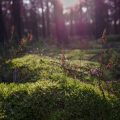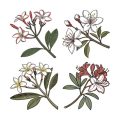Introduction to UK Wildflower Walks
Wildflower walks hold a special place in the hearts of those who cherish the British countryside. These walks are far more than a leisurely pastime; they represent a deeply rooted tradition that connects people with the changing seasons and the unique tapestry of native flora across the UK. The rolling meadows, ancient woodlands, and open heathlands burst into colour each year, offering a living showcase of biodiversity and local heritage. Culturally, wildflower walks evoke a sense of nostalgia and pride, often celebrated in literature, art, and community events. By exploring these natural habitats on foot, walkers gain an appreciation for conservation efforts and the subtle beauty found within Britain’s landscapes. This shared experience not only fosters wellbeing but also strengthens the collective commitment to preserving these habitats for future generations.
2. Top Regions for Wildflower Walks
The United Kingdom boasts an extraordinary variety of landscapes, each offering distinct wildflower spectacles throughout the spring and summer months. From sweeping meadows to rugged coastal paths, the following regions in England, Scotland, Wales, and Northern Ireland are renowned for their rich botanical diversity and accessible walking routes.
England
England’s countryside is dotted with Areas of Outstanding Natural Beauty (AONBs) and national parks that come alive with wildflowers. The Cotswolds are famed for rolling limestone grasslands rich in orchids and cowslips, while the Lake District offers vibrant bluebell woods and upland meadows. The South Downs’ chalk hills are home to rare species such as the bee orchid, making it a favourite amongst botanists and casual walkers alike.
Scotland
Scotland’s wildflower walks often feature dramatic backdrops of lochs and mountains. The Cairngorms National Park is celebrated for its heather moorland and alpine flora, particularly in late summer. On the west coast, the Isle of Mull and the Hebrides are carpeted with colourful machair – a unique coastal grassland supporting poppies, violets, and rare orchids.
Wales
Wales offers strikingly diverse terrain, from coastal cliffs to mountainous uplands. Pembrokeshire Coast National Park is renowned for its sea pinks and thrift lining the cliffs in spring, while Snowdonia presents montane wildflowers like purple saxifrage. The Brecon Beacons’ hay meadows also provide excellent opportunities to see native wildflowers in abundance.
Northern Ireland
Northern Ireland’s landscapes include lush woodlands, bogs, and coastal reserves. The Antrim Plateau supports distinctive blanket bog flora such as butterworts and sundews. In contrast, Murlough National Nature Reserve in County Down features dunes teeming with wild pansies and orchids during late spring and early summer.
Regional Highlights at a Glance
| Region | Key Locations | Notable Wildflowers | Accessibility |
|---|---|---|---|
| England | Cotswolds, Lake District, South Downs | Orchids, Bluebells, Bee Orchid | Well-marked footpaths; family-friendly routes |
| Scotland | Cairngorms, Isle of Mull, Hebrides | Heather, Alpine Flowers, Machair Species | Varied; some remote areas require planning |
| Wales | Pembrokeshire Coast, Snowdonia, Brecon Beacons | Sea Pinks, Saxifrage, Hay Meadow Flowers | Good public transport links; accessible trails |
| Northern Ireland | Antrim Plateau, Murlough NNR | Bog Flora, Orchids, Wild Pansies | Main sites offer boardwalks or clear paths |
With such a breadth of landscapes across the UK’s four nations, walkers can experience everything from easy-access nature reserves to more challenging rural hikes. Each region presents its own seasonal highlights—making it possible to enjoy spectacular wildflower displays no matter where your adventures take you.

3. When to See Wildflowers: Seasonal Highlights
Timing is crucial for experiencing the UK’s wildflower walks at their very best. The British climate, with its distinct seasons, shapes the blooming patterns of native flora, offering unique spectacles throughout the year. Below is a guide to help you plan your visits for peak wildflower displays and ensure you catch the most vibrant scenes.
Spring (March to May): Early Blooms and Woodland Carpets
Spring marks the beginning of wildflower season across the UK. From late March, ancient woodlands burst into colour with carpets of bluebells, wood anemones, and primroses. April and May are particularly magical in places like Kent’s Hucking Estate or Yorkshire’s Strid Wood, where you’ll find dense swathes of bluebells under fresh green canopies. Cowslips and wild garlic also thrive during this period, scenting the air along shaded paths.
Summer (June to August): Meadows in Full Glory
The summer months see wildflower meadows reach their zenith. June is ideal for spotting orchids—such as the common spotted orchid—in grasslands like those at Wiltshire’s Salisbury Plain or Cumbria’s Hay Meadows. July brings forth poppies, cornflowers, and oxeye daisies in open fields and roadside verges, especially in East Anglia and the Cotswolds. By August, heathlands such as those in Dorset or Northumberland glow purple with blooming heather, providing a quintessentially British landscape.
Autumn (September to October): Lingering Colour and Seeds
While many wildflowers have set seed by autumn, some late-bloomers still offer splashes of colour. Look out for devil’s-bit scabious and autumn crocus in damp meadows and woodland edges. This is also a rewarding time for observing seed heads and berries that attract wildlife—an often-overlooked spectacle that adds a different dimension to your walk.
Key Tips for Planning Your Walks
- Check Local Bloom Reports: Many nature reserves provide updates on current wildflower conditions.
- Weather Matters: A mild spring can bring early blooms; a cold spell may delay flowering.
- Peak Times Vary: Coastal areas and higher altitudes often flower later than lowland sites.
In Summary
The optimal months for wildflower walks in the UK range from early spring through late summer, with each region offering distinct highlights tied to local habitats. By aligning your visit with these seasonal peaks, you’ll witness some of Britain’s most enchanting natural displays—each walk revealing something new as the months progress.
4. Essential Wildflower Walks and Iconic Trails
For those eager to immerse themselves in the UK’s finest wildflower displays, certain walks and reserves stand out as truly unmissable. Drawing on the wisdom of local naturalists and seasoned walkers, we’ve compiled a detailed guide to some of the most celebrated wildflower destinations across the country. Each site offers its own distinctive character, from rolling chalk downs awash with orchids to ancient woodlands carpeted in bluebells.
Unmissable Wildflower Trails: At a Glance
| Trail/Reserve | Region | Best Time to Visit | Notable Species | Local Insider Tip |
|---|---|---|---|---|
| Cotswold Way (Cleeve Common) | South West England | Late May – July | Pyramidal Orchid, Cowslip, Wild Thyme | Arrive early morning for serene views and fewer crowds. |
| Moorland Walks (North York Moors) | Northern England | June – August | Heather, Marsh Orchid, Bog Asphodel | Spot rare butterflies on sunlit afternoons near Fen Bog. |
| Richmond Park | London | April – June | Bluebells, Early Purple Orchid, Cow Parsley | The Isabella Plantation is a must-see for vibrant spring carpets. |
| Bryn Euryn Nature Reserve | North Wales | May – July | Cowslips, Bee Orchid, Spotted Orchid | Follow the summit trail for panoramic coastal and floral vistas. |
| Durlston Country Park | Dorset Coast | June – August | Knapweed, Viper’s Bugloss, Horseshoe Vetch | Packed lunch recommended; picnic among blooms overlooking the sea. |
| Kew Gardens Wildflower Meadows | London (South West) | May – September | Cornflower, Red Campion, Poppy Mixes | Visit on weekdays for quieter pathways and expert-led tours. |
Expert Guidance: Making the Most of Your Walks
Cotswold Way (Cleeve Common)
This classic trail features sweeping limestone grasslands famed for their rich orchid populations. Local guides suggest following the marked circular route to experience the full spectrum of seasonal colour—look out for rare butterflies basking on sun-warmed slopes.
Moorland Walks (North York Moors)
The expansive heather moorlands burst into purple hues in late summer. For a less-trodden adventure, enthusiasts recommend exploring the valleys around Rosedale Abbey or joining ranger-led walks during peak blooming periods for expert insight on plant identification.
Bryn Euryn Nature Reserve (North Wales)
A compact but botanically diverse reserve, Bryn Euryn offers spectacular wildflower displays alongside historical interest. Locals favour evening strolls here as the setting sun enhances both the colours and tranquillity of this hillside haven.
Practical Tips for Responsible Enjoyment:
- Stick to marked paths to protect delicate habitats.
- Avoid picking flowers—capture memories with photographs instead.
- If walking a dog, keep it under control to prevent disturbance to wildlife.
Selecting any of these trails guarantees not only an encounter with remarkable British flora but also a deeper connection to some of the UK’s most treasured landscapes—all enhanced by insights from those who know them best.
5. Wildflower Identification and Etiquette
Tips for Recognising Common UK Wildflowers
Britain’s countryside is home to a rich tapestry of wildflowers, from the vibrant bluebells carpeting ancient woodlands in spring, to the striking red poppies that grace summer meadows. Familiarising yourself with common species such as primroses, cowslips, oxeye daisies, and foxgloves will greatly enhance your wildflower walks. Carrying a compact field guide or using trusted identification apps can help you distinguish between lookalike species. Pay special attention to leaf shape, petal arrangement, and flowering periods—these are key indicators for accurate identification. Many local visitor centres or wildlife trusts also offer free resources or guided walks for beginners keen to learn more.
Responsible Walking Practices
Respecting the natural environment is crucial during wildflower walks. Always stick to established footpaths to minimise disturbance to fragile habitats and prevent trampling rare or emerging plants. Refrain from picking flowers, as this not only diminishes their beauty for others but can also disrupt pollinators and the plant’s ability to reproduce. If you’re walking with children or pets, encourage them to observe rather than touch the flora. Remember: “Take only photographs, leave only footprints.”
Preserving Natural Habitats
The preservation of wildflower-rich landscapes relies on the collective effort of visitors. Avoid disturbing wildlife by keeping noise levels low and staying clear of nesting birds or other animals. Dispose of any litter responsibly—if bins aren’t available, take your rubbish home with you. Consider joining local conservation initiatives or volunteering for habitat restoration days; many UK organisations welcome extra hands during key seasons. By adopting these practices, every walker can contribute to safeguarding the future of Britain’s wildflower wonders.
Key Points to Remember:
- Use guides or apps for accurate flower identification
- Stay on marked trails at all times
- Never pick or uproot wildflowers
- Keep dogs under close control, especially near livestock and ground-nesting birds
- Support local conservation efforts when possible
Walking with Respect Ensures Wildflowers Thrive for Generations
By recognising native species and adhering to responsible etiquette, you not only enrich your own experience but help protect these cherished landscapes for future walkers.
6. Planning Your Wildflower Walk
To make the most of your wildflower walk in the UK, a bit of preparation goes a long way. Choosing the right route is paramount; research local nature reserves, National Trust properties, or Areas of Outstanding Natural Beauty (AONB) known for their seasonal blooms. Check recent reports or contact local wildlife trusts for up-to-date information on where wildflowers are currently flourishing.
Selecting Your Route
Consider your group’s fitness level and interests when picking a trail. Many regions offer well-marked circular walks, often with interpretive boards highlighting key species. If you’re keen to see rarer flowers, seek out specialist guides or walking clubs who regularly organise wildflower-focused outings.
What to Bring
- A detailed OS map or a reliable walking app
- A field guide or mobile app for plant identification
- Binoculars for spotting distant blooms and wildlife
- A camera or smartphone to capture highlights
- Reusable water bottle and light refreshments
Recommended Attire
The British weather is famously changeable, so dress in layers and bring a waterproof jacket even in summer. Sturdy walking boots are advisable, especially if venturing onto moorland or uneven ground. Don’t forget a sun hat and sunscreen for exposed paths—wildflower meadows can be surprisingly open to the elements.
Local Resources and Further Information
For up-to-date information on flower sightings and access conditions, consult regional Wildlife Trusts, the Woodland Trust, or local tourist information centres. Many areas also have dedicated wildflower societies or Facebook groups sharing real-time updates and tips. Engaging with these resources not only enhances your experience but supports ongoing conservation efforts.
Responsible Walking
Remember to stick to marked paths to protect delicate habitats and always adhere to the Countryside Code: leave no trace, avoid picking flowers, and respect local communities. With thoughtful planning and consideration, you’ll enjoy a rewarding and memorable wildflower walk amidst some of Britain’s most beautiful landscapes.


